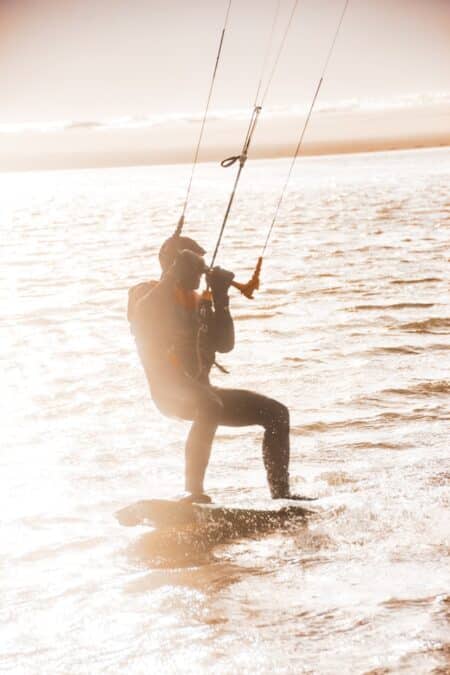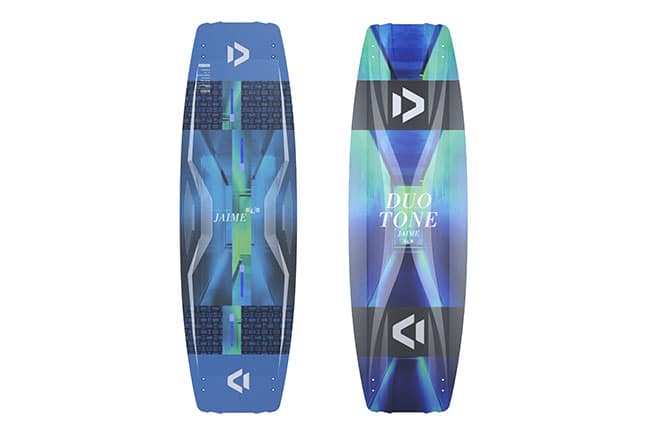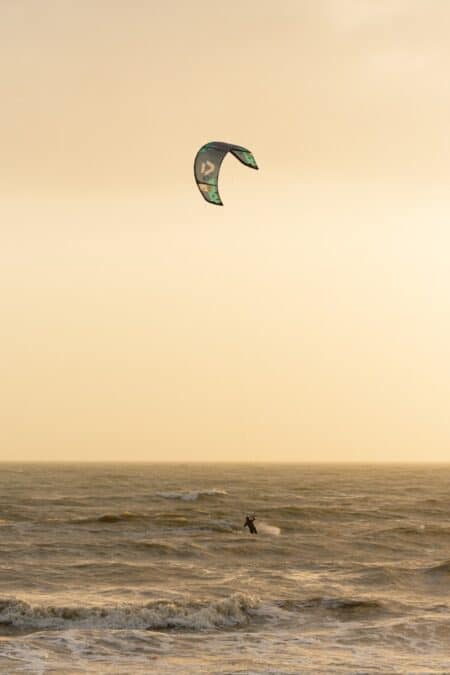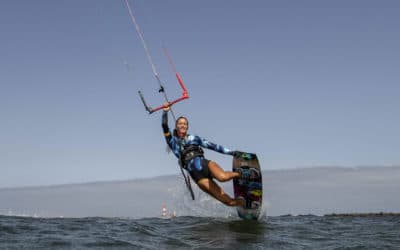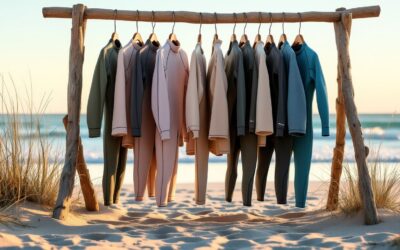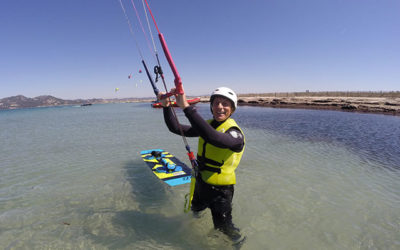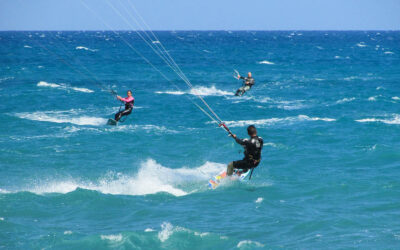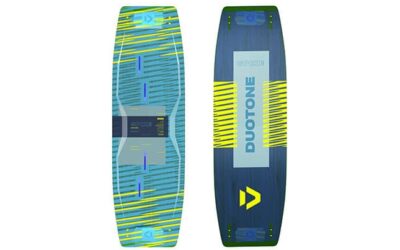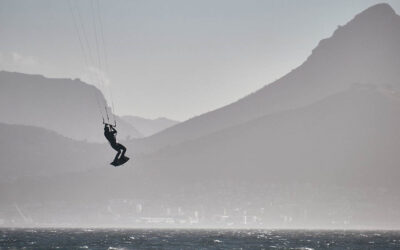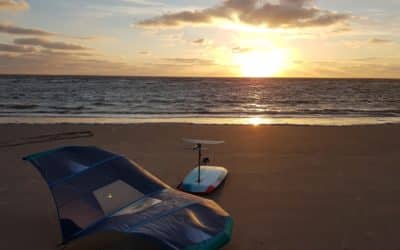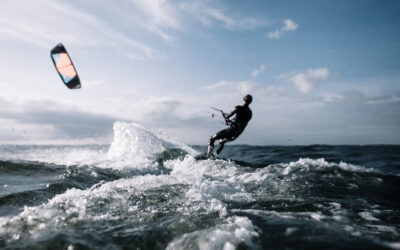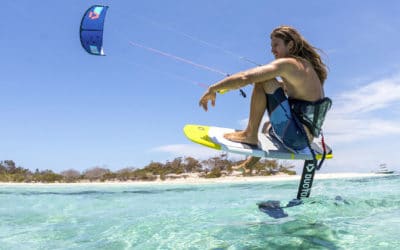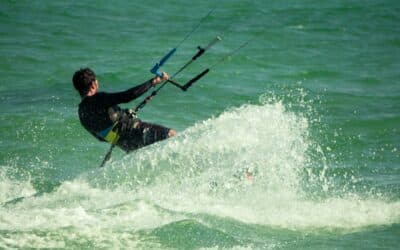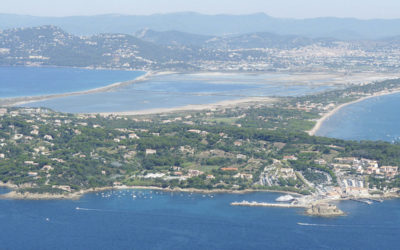How to Choose your Kitesurfing Gear: a Complete Guide
So, you’ve decided to embark on the kitesurfing adventure. Congratulations! You’re about to enter a world where the wind becomes your best friend and the sea your playground. But before diving headfirst into this new passion, there’s a crucial step you can’t overlook: choosing the right gear.
In Hyères, specifically in the legendary Almanarre Bay, Greg and Colin, your dedicated instructors at KGG kitesurfing school, are here to help you navigate the choices available to you. Whether you’re a beginner or already familiar with the sport, correctly selecting your kitesurf kite, your board, and your accessories makes all the difference.
Complete Anatomy of the Perfect Kitesurfing Gear Selection
Let’s start at the beginning: what exactly makes up your kitesurfing gear? Basically, you’ll need a kitesurf kite, a kitesurf board, a harness, and a few other small gadgets that will make you a true expert of waves and wind. But be warned, buying your first kit can tip the scales between brilliant success and painful failure if chosen poorly.
It’s imperative to consider several factors such as your skill level, the wind conditions you most often expect, and even your body size. The devil is in the details, they say, and this adage makes perfect sense when it comes to kitesurfing.
Kitesurf Kite: Catch the Wind
The kitesurf kite is undoubtedly the most significant investment. It’s your direct link to the elements, and its size must be adapted not only to your weight but also to the wind conditions primarily encountered. A mistake in kite size could literally send you tumbling into unknown territories.
It’s best to start with a medium-sized kite for easy control, especially as a beginner. As a guide, a kite around 10m² is often recommended for moderate winds. Never hesitate to ask for personalized recommendations from our experts Greg and Colin, who have seen more wind gusts than you’ve had bike falls.
- General beginner size: 9-12 m² depending on body weight and wind.
- For strong wind conditions: opt for a smaller kite for more stability.
- Always remember to test a used kite before buying, it’s often less financially risky.
Kitesurf Board: Cloud Surfer
Now let’s move on to the kitesurf board. Boards come in different sizes, shapes, and styles. Choosing the right one requires a keen understanding of your personal preferences and the kitesurfing style you’re looking to adopt, as every ride is different.
For a beginner, a wider board offers more stability and makes it easier to gain speed. That said, those looking for bold maneuvers will prefer a narrower, more reactive board. Again, the advice of seasoned experts will be of great help in refining your selection.
Assessments and Adjustments: Optimal Performance
Knowing how to “equip yourself also means knowing when to change your habits. Are you ready for an upgrade or are you not yet” at your best? Regularly test your equipment to check its condition and its suitability for your continuous progress.
Sometimes, giving a second life to high-performing used gear can save your wallet while keeping you on track with your sports goals. You just need to adopt a meticulous approach when checking potential parts and ensure they are still in good condition. Never relegate safety to the back of dusty closets when it comes to extreme sports.
Essential Kitesurfing Accessories
Finally, let’s not forget the crucial components that complete the picture. A comfortable and well-fitting harness, a wetsuit suited to water temperatures, a secure board leash, as well as a protective helmet and a reliable safety system; all constitute wise and sometimes vital investments for your overall safety and comfort.
Together, these accessories not only provide an extra dose of safety but also increase your enjoyment and peace of mind during each session on the “water. The” addition of each element helps form a coherent setup ready to defuse perilous situations normally reserved for movie scenes.
Pro Tips and Recommendations
Make sure to follow some practical tips to maximize your efficiency on the water. At “KGG school, Greg and Colin emphasize the importance of carefully observing your surroundings before jumping into the water. Take the time to check the” sky and wave conditions, and spot other kiteboarders to prevent possible collisions.
Furthermore, regular training and unwavering patience often yield results a thousand times superior to those rushed into. Adapting to an arduous discipline requires daily commitment and perseverance.
Wind Tips and Secret Tricks
Obviously, the weather plays a predominant role in all your future kitesurfing outings. Instead of sadly waiting ashore for Neptune to finally slap the waves, take a few strategic precautions: monitor forecasts meticulously and judiciously fit your preferred slot into your busy schedule.
There’s nothing worse than a kiter launching into overpowering gusts. So, create your own mental dance with the unpredictable wet conditions – guaranteed success before you see your competitive friends back on the dock under gloomy skies, still determined to brave it!
Frequently Asked Questions about Kitesurfing Gear Choice
What type of kitesurf board should I choose as a beginner?
For beginners, a wider and longer board is generally recommended. This type of board offers better stability on the water and makes it easier to get started. You might consider a classic twin-tip board, preferably with soft flex, to better absorb waves and thus ensure easier riding.
Is it recommended to buy used kitesurfing gear?
Yes, buying used gear can be an excellent option, especially for beginners looking to explore this sport without investing too much upfront. However, make sure to carefully inspect the condition of each piece, especially the kite and the board, to avoid any unpleasant surprises. Seek the advice of a professional like Greg or Colin if necessary.
What is the importance of wind conditions in kitesurfing?
Wind conditions are crucial in the kitesurfing experience. Stable and consistent wind is ideal for learning and progressing quickly. Too much wind can make riding dangerous, and a complete lack of wind will leave you grounded. It’s essential to adjust your kite size according to the conditions to stay safe while optimizing your performance.
What safety equipment is essential in kitesurfing?
Safety must always come first in kitesurfing. Besides the helmet, harness, and wetsuit, consider wearing an impact vest, which will offer you additional protection. Furthermore, make sure to have an accessible safety knife to cut lines in an emergency, as well as an effective leash to securely attach your board.
| Safety Equipment | Function | Importance |
|---|---|---|
| Helmet | Protects the head | Essential |
| Impact Vest | Torso Protection | Highly Recommended |
| Board Leash | Secure Board Attachment | Essential |
Search
Catégories
Recent Posts
- Visiting Hyères: a Journey between Paradise Beaches and Historic Treasures
- What to Do in Hyères when it Rains: a Guide for Successful Days
- Exploring Must-Do Activities in Saint-Maximin-la-Sainte-Baume
- Exploring Var Tourism: Hidden Gems and Adventures
- Discover Porquerolles: a Hidden Paradise in the Heart of the Mediterranean
Suivez-nous !
